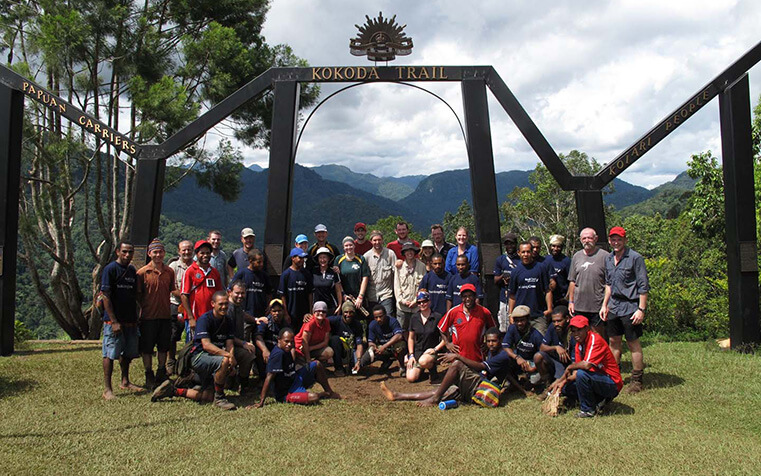Completing the Kokoda Track was one of the most challenging, rewarding, emotional yet exhilarating experiences of my life.
In April 2012, my husband Ian, my mum Sue, cousins Brett and Craig and friend Kellie headed off with a team of awesome trekkers to commemorate Anzac Day and also the 70th Anniversary since the battles began along the Track.
We knew it would be tough, we knew we had to train for it but nothing really prepared us for the environmental conditions we faced when we started the trek.
Our training program started 6 months before we were due to leave. Most weekends saw us training initially from Waterfall Gully to Mt Lofty then we moved on to more challenges at Black Hill and Morialta Conservation Park in mostly dry hot typical South Australian summer climate. We built up slowly to 3-4 hour hikes with backpacks weighing 5-15kgs in addition to our weekly fitness regimes of running, swimming, gym, climbing stairs or cardio work outs.
We had the option of having a porter carry a large backpack with most of our gear and then we could carry a day pack weighing about 5kg’s (note, this is a good idea on 2 levels – providing local employment opportunities and lightening the load on those slopes!) OR we could opt to carry our own packs weighing up to 15kg. So we trained according to what we decided to carry on the Trek. We honestly thought we were fit people (!) until we started hill training – the first sessions were a bit of shock to the system but week by week we gained fitness and when April arrived, we almost confidently felt we were ready to trek!
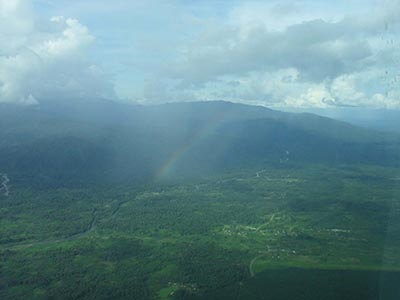
We flew to Brisbane and then Port Moresby, Papua New Guinea where our tour group “Back Track Adventures” organised us from start to finish – transferring us to our hotel, briefing us on the Track, organising our meals and accommodation before and after the trek as well as getting us flown over to Popondetta and Kokoda in time to start our trek as planned. In PNG nothing is confirmed 100% and it is soon apparent that when things change you have to adapt to the pace and culture with flexibility and an open mind – when our flight to Popondetta was downgraded from a 70 seater aircraft to a 50 seater (during check in), 12 of us were left behind in Port Moresby. Backtrack Adventures had us on 2 charter flights within hours and we caught up to the others and still made it to the planned camp site that night. The views of the Owen Stanley Ranges from our little 9 seater plane were incredible – the mountains seemed to go on and on and on.
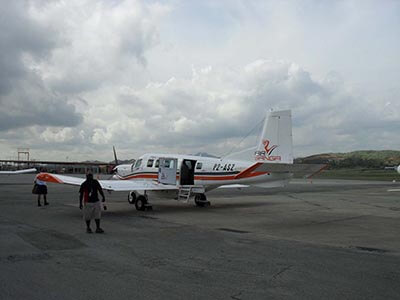
Our group Team 2A (which we renamed Team Awesome!) contained 2 leaders and 16 trekkers ranging in age from 24 to 59 years of age from Australia and Ireland. An awesome blend of families and friends that made this trip so memorable. Plus we had local villagers assisting as porters, cooks, general crew and local guides. Our head local guide, Andy was from the village of Naduri and his father Mr Ovoru Ndeki was one of the last surviving Fuzzy Wuzzy Angels. More on that later in Naduri …..
After a long day getting from Port Moresby to either Popondetta or Kokoda Village we had some time at the small museum and memorial at Kokoda (there is still a bullet marked palm tree at the memorial site) before rejoining the group and preparing to trek. Our guides painted the history scene for us explaining how the Japanese advanced from the coast to Kokoda when the Japanese first landed on the northern beaches. Seeing pieces of rusted old guns and ammunition in the museum reminded us of why were doing the Track and to understand the incomprehensible of what happened there in 1942.
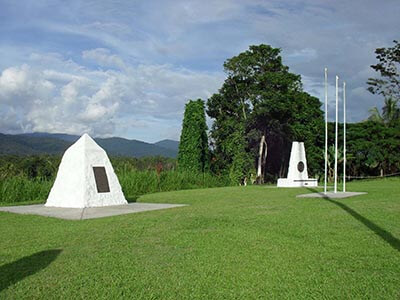
At this time, those who had arranged for porters met their buddies and we also met all the crew who would be assisting us with our trek. The local crew introduced themselves to each of us with quietly spoken voices and shy smiles. All crew members were male, some as young as 16 and were mostly from villages along the Track.
With a war cry like no other, thanks to our local guide Stanley, we hit the Track.
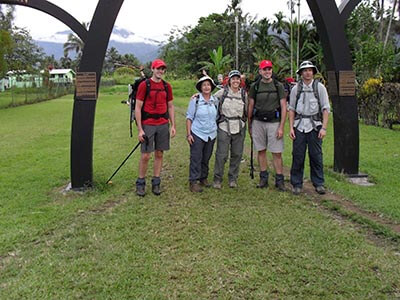
Kokoda to Hoi
Our first day on the Track was to be a short one – just 2 hours walk on relatively flat ground to our camp at Hoi. This would be the last flat ground we would see for awhile!!
Beautiful lush jungle, thick and green greeted us along with bugs and humidity as we were still fairly close to sea level. We got into camp after dark and a bit too late for a creek swim but thankfully our tents were already up ready for us to claim and settle in for the night. We had our “7.30 Report” (a name for our 6 oclock news – a nightly bulletin reflecting on the day and also a briefing on the next day). A hot meal of curried sausages and mashed potato appeared suddenly along with a beef soup and some sweet biscuits for dessert. As we had been up since 4am, most of us headed to bed pretty early. It was too hot and humid for a sleeping bag and as we all had our own tents, we could spread out and pray for a bit of breeze.
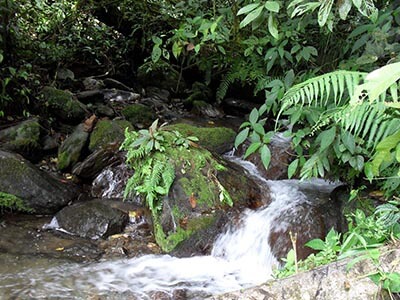
Hoi to Alola
Another early start (you may notice a pattern here) up at 5.30am to be on the Track by 6.30am. Our breakky consisted of a choice of thick porridge, cereal, damper and tea/coffee – most of us had not slept much and it was a slow start on International Roast.
We were saturated in sweat after just 15 mins from setting off and this was when the real climbing started. The conditions of the track changed swiftly to climbing upwards over tree roots and uneven ground up a hill that lasted 2 hours. Couple that with 90% humidity and a rising sun and all the training in the world couldn’t prepare us for what we were facing. The legs were tested early and it was evident after a few hours that many doubted whether they could make it through the next 8 days. I may have been one of those people. I’d opted to carry a full pack and gave my porter away when I arrived in Kokoda. I discovered the need for electrolytes and snacks to keep the sugar levels up. This did help my morale on the first tough section.
Our group leaders always waited for us slower ones (particularly those carrying their own packs) so we were never left behind for too long.
Around midday we passed through the village of Isurava where smiling villagers and children said hello. We were surprised to see packets of Twisties and cans of Coke for sale.
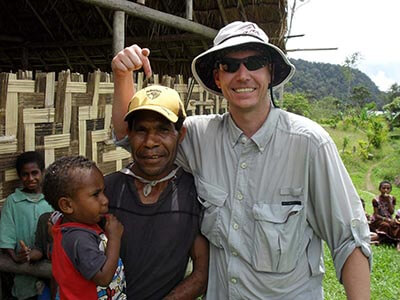
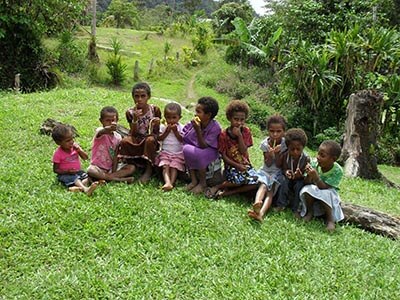
We rested for a bit here while a sidetrip was offered for those who were keen. Just off the Track on a hillside, a Japanese aircraft had crashed during the war but was only rediscovered in recent years. A small group of us left our packs on the Track and took the 30 minute steep climb up to the site with help of local villagers (because I hadn’t challenged myself enough today and I did get a case of FOMO). It was a little spooky to see the red dot part of the Japanese flag twisted and mangled in wreckage that was strewn across an area now overgrown with trees and moss.
We descended back down to the Track and continued on to the Isurava battle site for a late lunch of noodles, crackers, tinned meat and cheese. Our guides gave us a briefing on the significance of the site, the battles that took place, the memorial area and tributes to the Aussie soldiers who fought and died. Particular mention was given to Kingsbury who was given a Victoria Cross for his fearless, selfless contribution to the campaign. It was a place to reflect on the clear grassy area and enjoy the incredible views over the valley. So far, it had been a clear and sunny day – not what we had expected at all.
We continued on to Alola – our campsite for the second night. With a stream passing the site, most of us jumped straight in fully clothed to wash the day’s sweat away. The water was cold but incredibly refreshing and for just a brief moment, we felt clean again. A light rain fell at dusk and after a hot dinner of pasta and Tim Tams for dessert we had an early night.
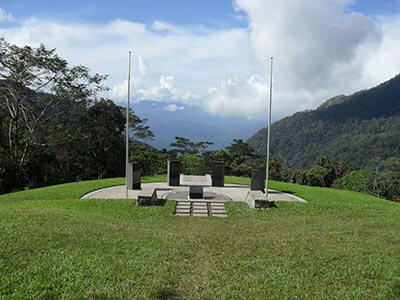
Alola to Templetons
Most of us were awake at 4am thanks to the local rooster. Packing ear plugs to block out the snorers and roosters were a great idea as I packed up my gear. Hindsight is awesome! We were up at 5am to set off at 6.30am – we needed a good hour and a half to pack up, have some breakky and get organised.
We headed off heading initially downhill for some time in steep valley. The downhill bits allowed us to chat amongst ourselves a little more and get to know each other. This was also the day I met Daba. He was to assist me until our final campsite ensuring that I had a hand to hold on the tough bits – for the massive step ups, the steep drops down and the muddy parts or where it was narrow and I might feel nervous. His help greatly preserved my knees and I have no doubt my knees would have been a lot sorer without his assistance (I only had to strap one knee for 2 days). Daba was in his 40’s and was from a village near Popondetta but he had moved to Naduri with his family a few years ago. He told me he had 3 children, 2 boys and 1 girl. His oldest son Charlie was a porter with another team and his youngest son Joel was 18. His daughter Rosalie was at Naduri with his wife and mother. I hoped to meet them when we passed through Naduri.
Today marked the first day of crossing rivers (often fast moving white water) on bridges made of logs with vine to hold onto.
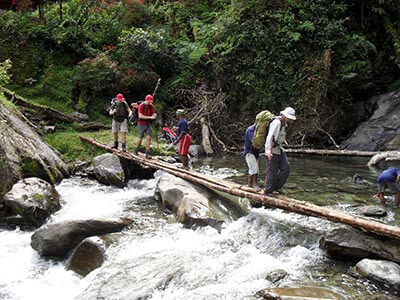
It was a little scary at first but with the presence of our crew, we all made it safely across. They only told us stories of those who fell in AFTER we crossed!
Along the way we took a small detour to a Japanese defence site where foxholes, grenades and helmets were left. The site had a view straight over Eora Creek which was tightly held by the Japanese due to the position of their defence. Any Australian soldiers attempting to cross this creek to fight were subject to direct fire from where the Japanese held position high up on the hill. It was a no-win situation. We descended all the way down the valley to this fast moving creek, crossed it and headed uphill for 2 hours before we had lunch. Our walk after lunch was just an hour and a half of mainly downhill, then we crossed the Eora Creek once more to our campsite. The water in this river was colder than at Alola and very fast moving.
This campsite called Templeton’s Camp was definitely one of my favourites as it was spacious and the sound of the water was so loud, it would drown out any snorers. The sad thing was that Australian soldiers had been buried here and were later exhumed and taken to Bomana War Cemetery. Posts mark where they were once buried and it was very close to where we were sleeping in our tents. As we finished our walking for the day quite early, it allowed us to write in our journals, take a long (or quick) wash in the super cold creek.
We had our 6 o clock news early with some popcorn and prawn crackers, plus hot drinks. My cousin read out an article that was written by a service person after the battle of Isurava. It was very emotional to listen to and after covering that part of the track that day, imagining injured soldiers with missing legs and other body parts struggling along anyway they could, with no torches or light as darkness fell. Most of our group were reduced to tears afterwards and we needed some silence and space to digest and recover from the reality of war on this Track. After briefing us on the next day we had our dinner of fried rice, pumpkin soup and family assorted biscuits. The Eora Creek was a very loud fast flowing river providing a peaceful backdrop allowing sleep to happen a little easier for some of us.
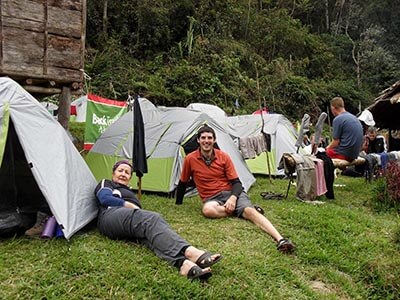
Templetons to Naduri
We had an earlier wake up call today to give us more time to get organised. We had to be on the track by 6 so we had a 4.30 wake up. After our brekky, the porters all gathered together and sang 3 songs with harmonies that gave us goosebumps and helped us forget about the challenges that lay ahead of us. The singing was incredible. My strongest memories are watching our crew sing their hearts out. Just for us.
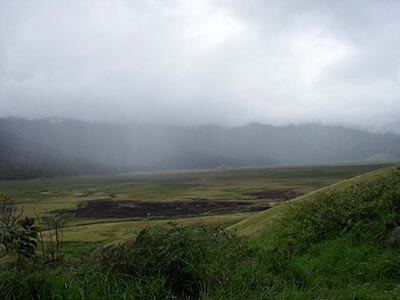
The first 2 hours of the day were straight uphill then we descended down to the Eora Creek to cross one last time. We climbed the highest peak of the Track, Mt Bellamy and on the way up this hill an oncoming Trekking group stopped and formed a guard of honour. Their crew were singing too. This act of support and fellowship reduced a few of us to tears – the struggle was clearly showing on our faces and bodies.
We kept going, heading downhill a little to Myola Lakes where a massive open area appeared out of nowhere. After all these hills and climbs, it was difficult to imagine a relatively flat area. It was swampy, but used during the war for supply drops. The rain in the distance was rolling in. We were told to put pack covers on and have our rain coats handy. We were spared the rain for another couple of hours.
We made it to lunch at Diggers Camp 45 mins later. This place was like a Garden of Eden – green grass, flowing streams and gorgeous plants. The sun was shining too so it made it even more beautiful. Many of our group laid down for a rest after lunch. A few were struggling with gastric upsets and of course fatigue.
The first 2 hours of the day were straight uphill then we descended down to the Eora Creek to cross one last time. We climbed the highest peak of the Track, Mt Bellamy and on the way up this hill an oncoming Trekking group stopped and formed a guard of honour. Their crew were singing too. This act of support and fellowship reduced a few of us to tears – the struggle was clearly showing on our faces and bodies.
We kept going, heading downhill a little to Myola Lakes where a massive open area appeared out of nowhere. After all these hills and climbs, it was difficult to imagine a relatively flat area. It was swampy, but used during the war for supply drops. The rain in the distance was rolling in. We were told to put pack covers on and have our rain coats handy. We were spared the rain for another couple of hours.
We made it to lunch at Diggers Camp 45 mins later. This place was like a Garden of Eden – green grass, flowing streams and gorgeous plants. The sun was shining too so it made it even more beautiful. Many of our group laid down for a rest after lunch. A few were struggling with gastric upsets and of course fatigue.
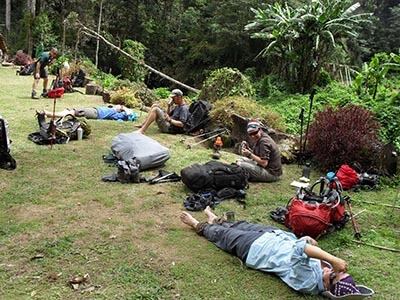
We set off for the final 2-2.5 hours to Naduri Village – it was a tough climb out of the lunch spot, then it was mostly downhill. Spirits despite all this, were pretty high – we talked and laughed a lot to take our minds off the different aches, pains and discomforts people were experiencing. Despite the rain that suddenly bucketed out of the sky, staying at Naduri we knew was going to be a highlight. The rain soaked us and our bags making them heavier than ever. Lots of us had slips and falls, including myself. I managed the splits (very inelegantly) and luckily didn’t get injured as I landed so close to a tree stump that nearly impaled my nether regions. Phew! My porter Daba was so apologetic when I fell. He didn’t let go of my hand after that until we made it to Naduri.
On arrival, the locals cheered and gave us flowers for the Anzac Day service in a couple of days. The rain finally stopped and we dried off as best we could and changed into dry stuff. There was clothes hanging everywhere in the guest hut where some of the trekkers were going to sleep that night instead of the tents. When I took my boots off my feet were very swollen and a funny looking rash was climbing both my legs. I think it was heat related but there was not a lot to treat it with, so just put some paw paw ointment on it and hoped it would clear.
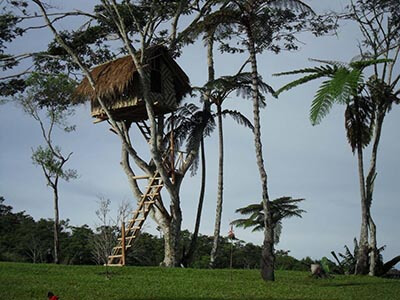
Tonight was going to be special. My porter Daba introduced me to his children Joel, 18 and Rosalie, 15. After our 6 o’clock news, we had a feast prepared by the local village women. There were so many lovely dishes to try, it was hard to fit it into the little bowls we had. As the line moved around the table, we sampled new foods like choko vine. There were vegetables in coconut milk, homemade pizzas, bread and local potato and sweet potato chips. The food was lovely and we felt so privileged to have been spoilt by the people of the village. As with previous nights, many (including myself) went to bed very soon after dinner. The women and children from the village came and sang songs – the trekkers returned with a rendition of Waltzing Matilda. The concert was apparently a highlight of the trek so far but as I went to bed feeling a bit under the weather, I was very disappointed to have missed it. Tomorrow though we would make our way to Brigade Hill in anticipation of Dawn Service the day after…..
To be continued……..
Lisa along with her husband Ian, Mum Sue, cousins Brett and Craig and trekking buddy Kellie completed the Kokoda Track with the awesome people who made up Team 2A in 2012 with Back Track Adventures – John, Briony, Mark, James, Michelle, Chervaughn, Joy, Greg, Terry, Shannon, Jamie and Mark along with leaders Martin and Tom. The crew and leadership offered on this trek made this experience unforgettable. Massive thanks to our friends at Back Track Adventures and local guides, porters, cooks and crew for looking after each and every one of us.
Additional Reading
Big Heart Adventures is a commercial tour operator (CTO). Offering walking adventures along the Kokoda Track and throughout Australia and overseas. We offer fully guided walking tours and self guided walking adventures.
You can see all our walking tours here.
Read more about ‘Big Heart Adventures’ and our wellness walks
Information on our women’s walking group ‘Wise Women Walking’
For more general information on the Kokoda Track head to Back Track Adventures

